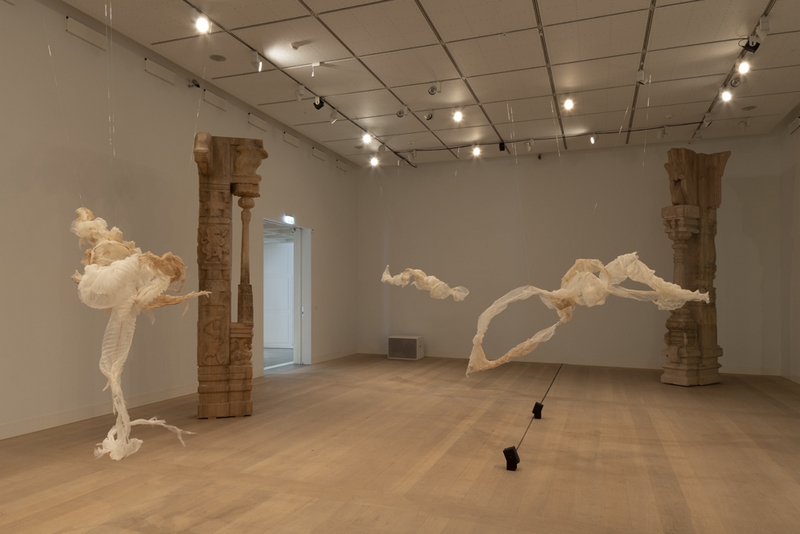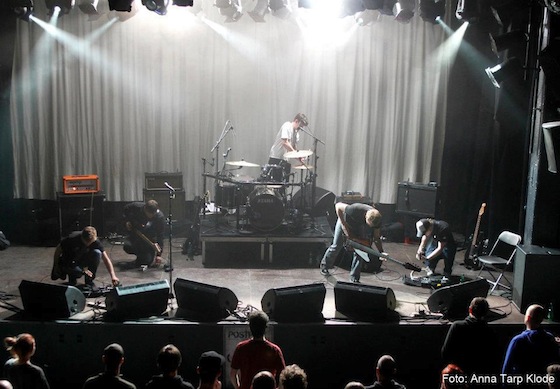Ursula Nistrup – The sound of sand and wind sculpting speculative alternatives to Planet Earth

Ursula Nistrup ”Cosmic Desert” (Resonans Recordings, 2019) – review by Wieland Rambke
In just a few weeks, on July 20, we will see the 50th anniversary of the moon landing. With mankind setting foot in outer space, we ourselves have become aliens: An extra-terrestrial species roaming the universe, visitors from a far-away planet. Should Elon Musk’s fantasies of space travel and interplanetary colonialisation come true, then being aliens will become part of what we are as a species.
The Alien and the Familiar play a crucial role on Danish artist Ursula Nistrups release ”Cosmic Desert“ which was conceptualised by Nistrup and realised by sound designer Peter Albrechtsen. The album presents two sound pieces that originally were used in her solo exhibitions.
While ”From the Pink Sand“ was part of a sculptural installation at the art museum in Holstebro, the album’s title track, ”Cosmic Desert“, is the soundtrack to a video work of the same title, first exhibited at Kunsthal Aarhus. Both works have their origin in new worlds created by Ursula Nistrup – new worlds that are speculative alternatives to Planet Earth. The soundworks as well as the exhibited pieces have the character of artifacts: ”From the Pink Sand“ conjures a species of massive mutated butterflies native to the Libyan Desert. The sound piece itself is primarily composed of recordings of sand, deep drones and the sounds of wind and storms which make the piece a dense composition that is hypnotic, yet unsettling at the same time. A sense of dread pervades the elegic piece.
From this soundscape, the voice of Cæcilie Trier emerges and disappears again, freely floating through the piece. At its heart, this work is an interplay between voice and natural sound: One of the inspirations behind “From the Pink Sand” is a tribe described in Nnedi Okorafor’s science-fiction novel ”Who Fears Death“. Briefly, it mentions a nomadic people that live inside a sandstorm. There is no clear distinction between the people and their natural surroundings, which has a crucial influence on their language: All personal names of this tribe start with specific sounds that can be made out easily against the noise of the storm.
This is emulated by Cæcilie Trier in multiple forms: Her voice is constantly moving between breaking away from, and blending into the soundscape. Her singing is a freeform play with words taken from a Berber dialect of the North of the Sahara Desert, words that describe natural phenomena such as „sharr“ (sand) and „aman“ (water). Nistrup’s idea was to create a new form of language that is both suppressed and amplified by the noise of sand. An implicit message is carried here: Humanity is only human where it starts separating itself from its natural surroundings. At the same time, the human race itself is only one of the many manifestations of nature as a whole.
The piece has a ritualistic ring to it. And the employment of complex, irregular natural sound phenomena means to invite nature as an unruly collaborator, even more: to interprete nature as an unforeseeable improvisational composer. A longing, sorrowful emotional space is created. As a whole, the music is strangely static – which seems fitting for a piece that accompanies statues. Aesthetically, ”From the Pink Sand“ is faintly reminiscent of the work of ritual ambient groups like Arktau Eos.
Through the heavy use of natural sounds as both background and as a compositional ingredient, the music appears as something hidden within itself. With this piece, songs and language are acknowledged as local properties, as a part of an acoustical eco-system, as the audible manifestation of what we call a place.
The second work on the release sees a different approach: ”Cosmic Desert“ is centered around a video of a piece of Libyan Desert Glass, a type of glass that has been used in jewellery as early as in Ancient Egypt. Tutankhamun’s royal brooch, for instance, featured a scarab made of desert glass. Again, the artifact-like nature of the piece is pointing to a fantastical origin, an alternative world created by Ursula Nistrup: An ant species is inhabiting a desert littered with glass pieces which are said to be the shattered remains of a meteorite. Through time, an ant religion has come into being, a religion centered around the worship of these glass shards. The sound piece itself works like an antithesis to ”From the Pink Sand“.
Although just as densely layered, the sound material here is sharp, fittingly glass-like, of a glowing and almost blinding quality. Instead of conjuring a wide open area, ”Cosmic Desert“ creates a suffocating, claustrophobic space. ”Cosmic Desert“ also employs natural noises. Rustling, creaking and dripping sounds abound, but they are met with sine waves slowly rising and falling, which serve as an atmospherical counter-weight to the punctual use of natural noises.
What the two pieces on this release have in common is that in both cases, the music oscillates between emphasis and attenuation of its individual strands, constantly reconfiguring the relations between its basic elements. As a whole, the release opens up a place to dream. Texture and atmosphere are the key elements in these pieces. The context of an imaginary, yet recognizable world allows us to take a step back and to understand ourselves as a phenomena of nature. Furthermore, it makes us reconsider what we accept as familiar, and what we see as fundamentally alien.
Info: ”Cosmic Desert” was released on Resonans Recordings in April.



